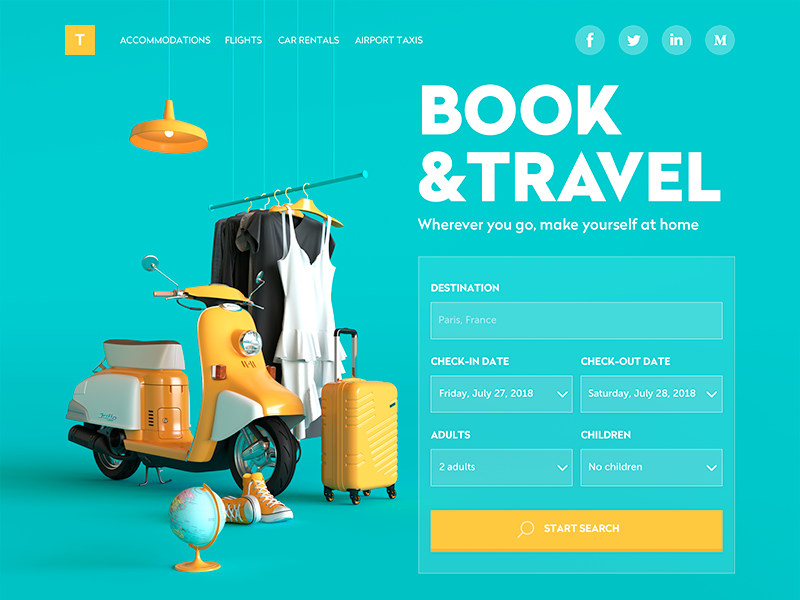Website Design London Ontario That Turns Visitors into Customers
Wiki Article
How to Successfully Combine Aesthetics and Performance in Web Style
When making a site, you require to strike a balance in between aesthetics and performance. It's not practically looking excellent; your design must additionally serve a purpose and guide individuals efficiently. By concentrating on simpleness and user-friendly navigating, you can produce an interesting experience. But what aspects absolutely enhance usability while preserving visual charm? Let's check out the crucial concepts that can cause an unified mix of elegance and feature.Recognizing the Importance of Appearances and Capability
Comprehending the equilibrium between aesthetic appeals and performance is vital for developing an effective individual experience when you create a web site. A visually appealing website grabs interest, but it's the functionality that maintains individuals engaged. If your website looks wonderful however is challenging to browse, site visitors will rapidly shed passion and leave.Consider your target audience and what draws them in. You desire to produce a design that shows your brand while making certain simplicity of usage. Streamlined layouts, instinctive navigation, and clear phone call to action can boost both looks and functionality.
Concepts of Effective Website Design
To develop a reliable internet design, you require to adhere to several vital concepts that enhance both individual experience and aesthetic charm. First, prioritize simplicity; a tidy design assists customers browse conveniently. Use a constant color pattern and typography to preserve coherence across your site. This fosters familiarity and trust.Next, assure your design is receptive. Customers access websites on various devices, so your layout needs to adjust flawlessly. Focus on aesthetic power structure; emphasize essential aspects with positioning, dimension, or color to lead customers' focus.Finally, include enough white area. It stops clutter and makes content more absorbable. Bear in mind, reliable web design equilibriums aesthetic appeals and performance, so every design selection must offer a purpose. By following these concepts, you'll create a site that's not just visually appealing but also straightforward, inevitably keeping site visitors engaged and urging them to return.Prioritizing Customer Experience
When prioritizing individual experience, you'll intend to start by recognizing what your users absolutely need. Streamlining navigation style can make a big distinction in how quickly they locate what they're searching for. Improving aesthetic power structure helps direct their focus to the most important elements on your site.Comprehending Customer Demands
Recognizing individual requirements is necessary for producing an engaging web experience that maintains site visitors coming back. To achieve this, you have to recognize the objectives and choices of your target market. Begin by conducting user study, like studies or meetings, to collect insights on what individuals worth most. Take notice of their discomfort factors and challenges when connecting with comparable sites. This details allows you to customize your design, ensuring performance aligns with individual assumptions. Furthermore, take into consideration producing customer personalities that stand for different sections of your audience, assisting you envision their needs throughout the layout process. When you focus on recognizing user demands, you create a web site that not just looks terrific yet also provides a smooth, delightful experience that fosters loyalty.
Streamlining Navigating Design

Enhancing Aesthetic Hierarchy
A strong aesthetic hierarchy is crucial in directing customers through your internet site and ensuring they engage with vital content. To attain this, use size, shade, and spacing strategically. Make crucial components like headings larger and bolder than body message, drawing interest immediately. Use contrasting shades to highlight calls to action, motivating clicks. In addition, employ sufficient white area to different areas, making content absorbable and inviting.Consider the circulation of details; arrange aspects practically, leading customers' eyes from one point to the next. Use visual hints, like arrows or lines, to guide focus. By focusing on aesthetic power structure, you enhance user experience and increase the possibility of conversions, guaranteeing your web site is both visually pleasing and functionally efficient.Shade Concept and Its Effect on Functionality
While selecting the ideal shades for your web site may look like a minor detail, it significantly influences functionality and user experience. Color affects just how customers regard info and can improve or impede navigating. For example, contrasting shades can assist essential elements attract attention, making it less complicated for site visitors to find what they need.Additionally, take into consideration the psychology of shades: blue frequently influences count on, while red creates necessity. Recognizing your target audience can guide your shade choices, assuring they resonate well.Moreover, regular color design assist develop brand name identification, making your site more unforgettable. However, be mindful-- a lot of colors can bewilder users. Stick to a restricted palette that matches your web content and maintains clarity.Incorporating access is also necessary; verify your color mixes are friendly for those with visual problems. By thoughtfully applying color concept, you'll boost usability and produce an extra engaging individual experience.Typography: Harmonizing Design and Readability
Shade choices set the stage for your internet site, but typography plays an equally necessary duty in enhancing user experience. You want your text to interact plainly while additionally mirroring your brand's character. Beginning by picking typefaces that are not just eye-catching but additionally clear. Sans-serif font styles usually work well for digital screens, as they're easier advice to review at numerous sizes.Maintain a power structure by utilizing different font style sizes and weights; this guides users through your content easily. Consider line spacing and letter spacing; too limited can discourage viewers, while also loosened can disrupt the flow. Limit your typeface options to two or 3 to maintain the design cohesive.Finally, always evaluate your typography across different gadgets and internet browsers. What looks great on one screen may out an additional. Stabilizing style with readability guarantees that your message reverberates, maintaining your audience engaged and educated.Responsive Layout: Making Aesthetics Work With All Tools
To ensure your website looks great on any kind of gadget, you'll need to welcome responsive layout principles. This approach warranties your site adapts to numerous screen sizes, supplying an optimal user experience. Beginning by utilizing fluid grids and adaptable pictures that scale seamlessly. Rather than repaired measurements, choose for percents and family member devices, enabling your format to change dynamically.Next, implement media inquiries in your CSS. These allow you apply various styles based on tool qualities, like display width. In this manner, you can maintain aesthetic allure while guaranteeing functionality.Don' t forget touch targets; make sure buttons and links are very easy to tap on smaller sized screens. Prioritize crucial content, so individuals can easily navigate your site regardless of their tool. By concentrating on these aspects, you'll develop an engaging, visually appealing experience that satisfies the demands of all customers, whether they're on a smartphone, tablet, or desktop computer .Performing Usability Testing for Continuous Improvement
To enhance your website design, you need to set clear usability goals that align with user needs. By conducting user tests, you can collect beneficial responses on just how actual individuals engage with your site. Evaluating these results will aid you make educated renovations and produce a much more effective user experience.Specifying Functionality Goals
While aesthetics can attract customers in, defining usability objectives is essential for guaranteeing their experience continues to be seamless and rewarding. Beginning by determining what you want users to achieve on your website (website design london Ontario). Consider their tasks, needs, and actions. Are they seeking info, buying, or registering for a newsletter? Develop clear criteria to gauge success, like task conclusion rates or time on job. Prioritize user-friendly navigating, available web content, and receptive layout to boost functionality. On a regular basis revisit these objectives as user assumptions evolve. By defining functionality objectives, you create a structure for evaluating and enhancing your internet site's performance. This concentrate on use not only enhances user contentment but likewise enhances the total efficiency of your layoutConducting Individual Examinations
Performing user tests is vital for improving your website and ensuring it meets your audience's requirements. Begin by recognizing your target customers and developing an examination plan that outlines your objectives. Use a mix of qualitative and quantitative techniques, such as studies, meetings, and task-based monitorings, to collect thorough feedback. Invite individuals to browse your website while you observe their communications and keep in mind any type of problems they come across. Motivate open dialogue to catch their thoughts and feelings concerning the layout and capability. Maintain sessions brief and focused, ensuring you cover key areas without frustrating customers. Make sure to document all findings, as this details will be important for making educated design decisions that boost both appearances and use.Examining Test Outcomes
Exactly how can you article efficiently analyze the outcomes of your usability examinations to drive constant improvement? Beginning by categorizing responses into common styles. Look for patterns in customer behavior that highlight discomfort points or locations for enhancement. Usage quantitative information, like task conclusion prices and time on task, to gauge functionality fairly. Don't neglect to think about qualitative understandings from individual remarks; they typically disclose underlying problems that numbers can not show. Focus on one of the most impactful findings and produce workable items for your style group. Remember, it's concerning iterating-- apply changes, after that examination again. This cycle of testing, assessing, and refining helps you balance aesthetics and performance, guaranteeing your internet site satisfies individual demands effectively while preserving aesthetic allure.Frequently Asked Concerns
Just how Do I Select the Right Shade Scheme for My Website?
To select the ideal shade scheme for your internet site, consider your brand's personality, target audience, and emotional effect (website design london Ontario). Usage shade psychology, develop consistency, and assurance readability. Test mixes to see what resonates finest with visitorsWhat Equipment Can Assist With Website Design Aesthetics and Functionality?
You can use tools like Adobe XD, Figma, and Sketch to enhance your website design's visual appeals and functionality. These platforms offer intuitive interfaces, partnership functions, and pre-made design templates to improve your creative process and improve your layouts.Just How Can I Integrate Animations Without Jeopardizing Functionality?
To incorporate computer animations without endangering capability, focus on subtle results that boost individual experience. Use CSS computer animations for smoother communications, assurance quick load times, and test on different devices to maintain efficiency while including visual appeal.What Prevail Blunders to Stay Clear Of in Web Design Visual Appeals?
When designing, stay clear of messy formats, bad color selections, and inconsistent more information typefaces. Don't overlook mobile responsiveness, as it can push away users. Verify your design straightens with your brand, developing a seamless experience that involves visitors properly.Just how Typically Should I Update My Website's Layout for Optimal Aesthetics?
You must upgrade your site's layout every 1-2 years to stay up to date with fads and maintain suitable visual appeals. Regularly renewing visuals aids involve warranties and visitors your site continues to be straightforward and enticing. When you develop a web site, recognizing the balance between looks and capability is important for producing an efficient customer experience. To develop a reliable internet layout, you require to adhere to several essential principles that improve both customer experience and aesthetic allure. Customers accessibility websites on various devices, so your design ought to adapt perfectly. When prioritizing individual experience, you'll want to start by understanding what your users really need. Start by carrying out user research, like interviews or surveys, to gather insights on what customers worth most.Report this wiki page